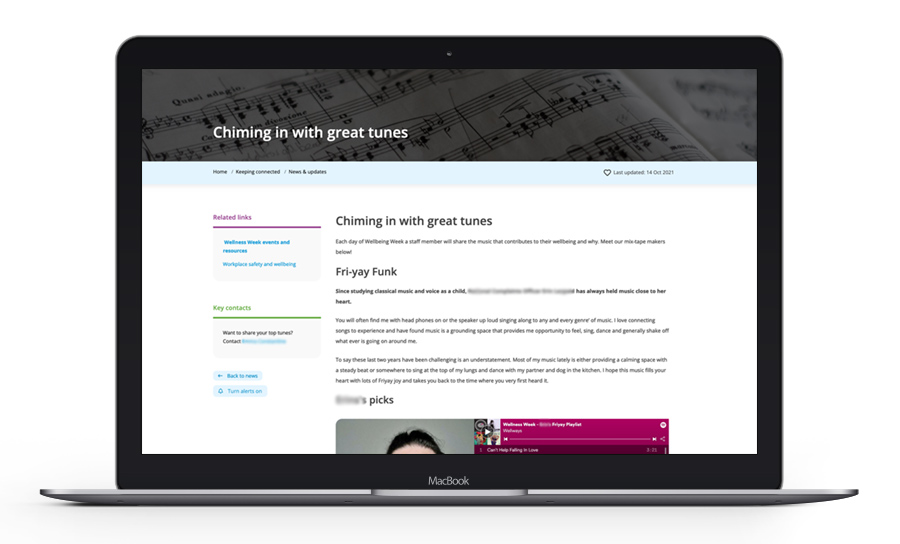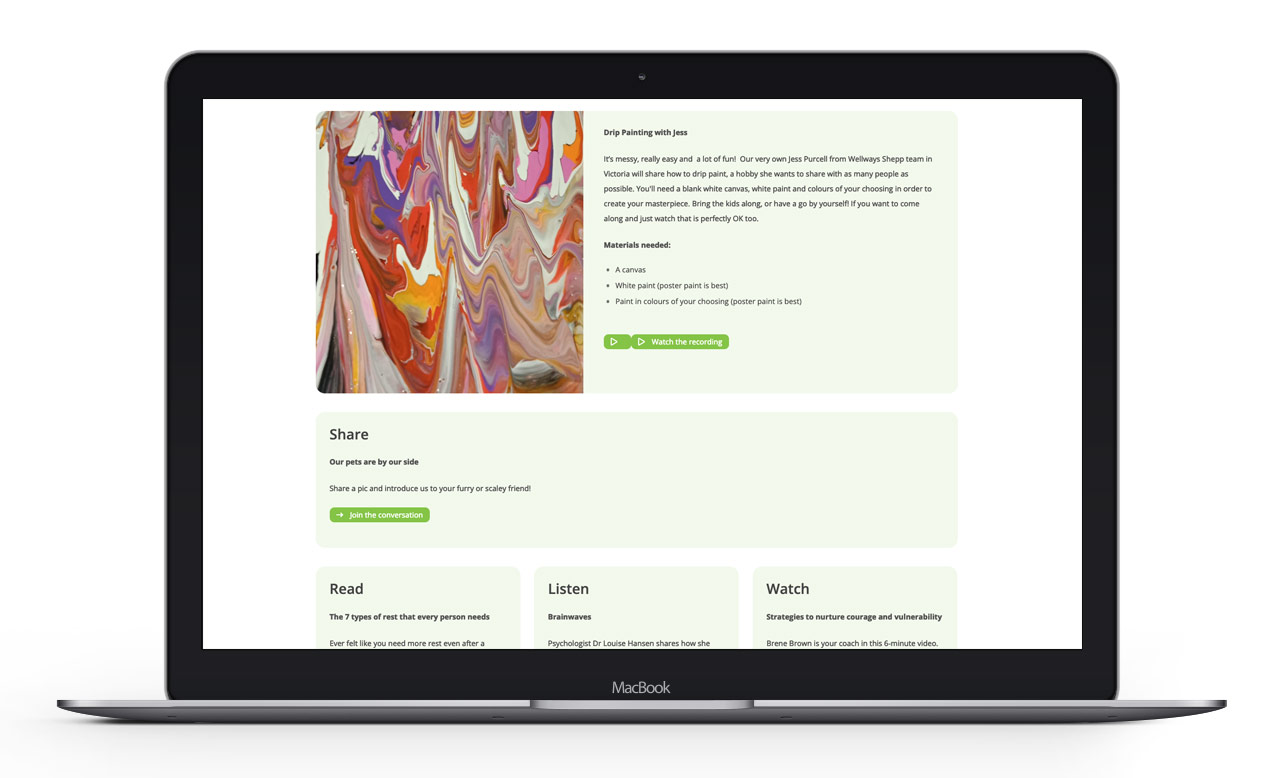A staggering 85% of employees report that workplace wellness programs positively impact their work-life balance. This statistic underscores the importance of leveraging every tool at our disposal to enhance employee wellbeing.
An intranet, traditionally seen as a hub for corporate communications and resources, is now emerging as a powerful platform to amplify wellness initiatives.
The concept of an 'employee wellness intranet' is a strategic approach that aligns with the holistic growth of an organisation and its people.
By integrating wellness into the daily digital experience of employees, organisations can create a more engaged, productive, and, ultimately, healthier workforce.
In this post, we explore how intranets can support employee health and wellbeing.
Why is Employee Wellness Important?
Employee wellness transcends beyond the basic concept of health and safety in the workplace. In this digital age, it is becoming an important digital workplace trend to consider.
Why does the employee experience matter? It encapsulates mental, physical, and emotional wellbeing, directly influencing productivity, engagement, and job satisfaction.
A study by the Global Wellness Institute revealed that companies with effective wellness programs see an 8% improvement in employee productivity and a 25% reduction in absenteeism and turnover. When employees are healthy, energetic and motivated, they tend to be fulfilled, happier and have healthier habits at work. The opposite is also true. These figures highlight the tangible benefits of investing in employee wellness.

The use intranet to foster employee wellness is a strategic move. It serves as a centralised platform where employees can access wellness resources, participate in health-related activities, and connect with peers on wellness topics. This can also be personalised by teams, locations and other key groups.
By integrating wellness into the intranet, companies can ensure that these resources are easily accessible, engaging, and tailored to the needs of their workforce.
Ways Your Intranet Can Support Employee Wellness
Let's explore how you can amplify wellness initiatives with your intranet.
Creating a Dedicated Wellness Portal
Your intranet can serve as a central hub for all wellness-related activities and information. By creating a dedicated wellness portal, you provide employees with easy access to resources that promote health and wellbeing.
For instance, you could include a 'Wellness Calendar' featuring daily health tips, weekly exercise challenges, or mindfulness exercises. Incorporate a mix of written articles, video tutorials, and interactive quizzes to cater to different learning preferences. Additionally, feature success stories or testimonials from employees who have benefited from the wellness program, providing motivation and real-life examples of the program's impact.
Enabling Flexible Work Arrangements
The intranet can be a powerful tool in facilitating flexible work arrangements within your digital workplace for remote employees. With features such as shared calendars, task management tools, and collaborative workspaces, employees can efficiently manage their work while maintaining a healthy work-life balance. This flexibility is crucial in reducing stress and improving overall job satisfaction, directly impacting employee wellness.
It also integrates project management tools and digital workspaces that allow for seamless collaboration, regardless of physical location. This not only supports physical wellness but also contributes to mental wellbeing by reducing stress associated with rigid work schedules.
You could also have an 'Availability Indicator' where employees can signal their working hours, especially if they are working remotely or following a flexible schedule. This feature helps in respecting personal time and reducing the likelihood of burnout. For example, if you integrate your intranet with Microsoft Teams, colleagues will be able to see if their team mates are online!
For more information, check out the related post on 'Overcoming Remote Working Challenges with an Intranet'.
Offering Online Health and Well-being Resources
Incorporate a variety of online resources into your intranet to support employee health and wellbeing.
This could range from a 'Virtual Health Desk' offering advice from healthcare professionals, to on-demand fitness classes catering to different fitness levels.
Consider incorporating a 'Mental Health Corner' with resources on managing stress, anxiety, and other mental health issues.
To encourage engagement, you could introduce a gamification element where employees earn points or badges for participating in different health and wellness activities available on the intranet.
Promoting Employee Wellness Programs
Use your intranet to actively promote and amplify wellness initiatives within your organisation.
For instance, you could create a dedicated section for 'Monthly Wellness Challenges' where employees can sign up for activities like step-count challenges, healthy eating weeks, or mindfulness sessions. To make these programs more engaging, incorporate interactive elements such as leaderboards, progress trackers, and reward systems that acknowledge and celebrate employee participation and achievements.
You could also use the intranet to host virtual wellness events, such as live-streamed yoga sessions or webinars on health topics, making them accessible to all employees regardless of their location. There are a range of newsletter ideas such as digital wellness distributed through the intranet that can work well, keeping employees informed about upcoming events, new health resources, and tips for maintaining a healthy lifestyle.
Wellways, for example, launched an intranet that promotes a positive culture and collaboration for all staff members through publishing cross-team news and positive success stories, discussions in online communities and sharing updates in social feeds.
They also have sections dedicated to employee wellbeing and promoting connectivity among their distributed workforce who work across the country.
'Chilling in with great tunes' is an area where staff members share the music that has contributed to their wellbeing and why.

It also promotes content that can be read, listened to or watched to encourage activities that can be done at home such as painting lessons.

These wellness activities encourage employees to take time away to focus on positive activities for their own mental health.
Facilitating Employee Communication
Communication is key in any wellness program.
Create forums or discussion boards where employees can share experiences, advice, and encouragement related to health and wellness topics. These platforms can also serve as a space for employees to form support groups, such as running clubs or healthy cooking groups, encouraging peer-to-peer motivation and accountability.
The intranet can also facilitate anonymous feedback or surveys, allowing employees to voice their opinions or concerns about the workplace environment and wellness programs. This feedback can be invaluable in tailoring initiatives to better meet the needs of your workforce. Additionally, consider incorporating a 'Wellness Q&A' section where employees can ask questions anonymously and receive answers from qualified professionals.
Best Practices for Digital Experiences
Let's delve into some best practices to ensure your employee wellness intranet provides an engaging, supportive, and effective digital experience for all employees.
Make the Intranet Easy to Use and Accessible
Accessibility is key in ensuring that all employees, regardless of their technical skills or physical abilities, can benefit from the intranet.
To enhance usability and accessibility, consider the following:
- Design and Layout. Start by focusing on the design and layout. The interface should be clean and clutter-free, with a logical structure that guides users naturally to the most important sections. Utilise clear headings, well-organised menus, and a consistent design template across all pages.
- Accessibility. Accessibility also means ensuring the intranet is usable for people with disabilities. This includes providing alt text for images, ensuring screen reader compatibility, and offering keyboard navigation. Remember, an accessible intranet is not just about compliance; it's about inclusivity.
- Mobile Optimisation. Optimise the intranet for mobile devices. With the increasing trend of remote working, employees should be able to access the intranet seamlessly from their smartphones or tablets. This involves responsive design that adjusts to different screen sizes and touch-friendly navigation.
- User Journey. Regularly conduct user experience (UX) audits to identify any pain points. Use tools like heat maps or user feedback to understand how employees interact with the intranet and make necessary adjustments to improve their experience.
Provide Engaging and Informative Content
The content on your intranet should not only be informative but also engaging.
Consider the following:
- Diversity. The content on your intranet should cater to the diverse needs and interests of your workforce. Start by identifying the key content areas that are relevant to your employees. This might include company news, HR policies, wellness resources, and department-specific information.
- Vary Formats. Incorporate a mix of formats such as videos, podcasts, infographics, and interactive modules to cater to different learning and engagement preferences. For example, instead of long text documents, break information into bite-sized, digestible pieces. Use infographics to explain complex data, videos for training materials, and interactive quizzes for learning and development content.
- Personalisation. Use data analytics to offer content recommendations based on user preferences and past interactions. For instance, if an employee frequently accesses health and wellness articles, the intranet could suggest similar content or upcoming wellness events.
- Regular Updates. Regularly update the content calendar to keep the intranet dynamic and interesting. Plan for regular posts, updates, and features. For instance, a weekly CEO blog post, a monthly department highlight, or regular updates on ongoing projects can keep employees coming back for more.
- Tone and Style. It should reflect your organisation's culture and values. If your workplace is more formal, a professional tone might be appropriate. However, for more casual environments, a conversational and approachable tone can make the content more relatable.
Keep Content Up-to-Date and Relevant
An intranet filled with outdated information can quickly become irrelevant. Maintaining the relevance and freshness of content on your intranet is crucial.
This involves a proactive and strategic approach to content management:
- Regular Content Audits. Conduct periodic reviews to assess the accuracy, relevance, and timeliness of the information. Remove outdated materials, update any changes in company policies or procedures, and refresh sections that may have become stagnant.
- Dynamic Content Strategy. Develop a content calendar that aligns with your company’s events, milestones, and industry trends. For instance, if there's an upcoming change in industry regulations, preemptively provide resources and training materials on these changes. Similarly, align content with internal events like wellness weeks or company anniversaries.
- Employee Contributions. Encourage departments and teams to contribute to the intranet. This could be in the form of department updates, project highlights, or sharing professional insights. Employee-generated content not only diversifies the information but also increases engagement as employees see their contributions valued.
- Feedback Loop. Implement mechanisms for employees to suggest content ideas or report outdated information. This could be a simple feedback form or a more integrated approach like a content suggestion box on the intranet homepage.
Encourage Employee Feedback and Participation
An intranet is a two-way communication channel. Encourage employees to provide feedback on the content and features of the intranet.
An intranet should be a dynamic, interactive platform where employees feel heard and involved:
- Interactive Features. Incorporate features like polls, surveys, and discussion forums. These tools can be used for gathering feedback on various topics, from the intranet user experience to opinions on workplace initiatives.
- Recognition Programs. Use the intranet to recognise and celebrate employee achievements. This could be through highlighting individual or team successes, acknowledging work anniversaries, or celebrating professional milestones. Recognition fosters a positive workplace culture and encourages others to participate and engage.
- Collaborative Spaces. Create spaces within the intranet where employees can collaborate on projects, share ideas, and work together. This could be in the form of project workspaces, shared digital whiteboards, or brainstorming forums. These collaborative environments not only facilitate teamwork but also enhance the sense of community.
- Training and Development. Utilise the intranet to offer training and development resources. This could include e-learning modules, webinars, and professional development courses. By providing opportunities for growth and learning, you encourage employees to engage more deeply with the intranet and invest in their own professional growth.
Conclusion
In conclusion, how intranets can support employee health and wellbeing cannot be overlooked. With 70% of employees more likely to stay at a company that shows a high commitment to health and wellness, the message is clear: wellness initiatives are not just a perk but a crucial element of a company's value proposition.
By leveraging the power of an intranet, organisations can amplify wellness initiatives, creating a more vibrant, healthy, and productive workplace.
The journey towards a healthier workplace is continuous and evolving. An employee wellness intranet is more than just a tool; it's a reflection of a company's ethos and commitment to its most valuable asset - its people. As we forge ahead in these ever-changing times, let us remember that the health and wellbeing of our employees are the bedrock upon which successful businesses are built.
Want to understand additional ways to build a productive and engaged digital workplace? Check out our free guide.
